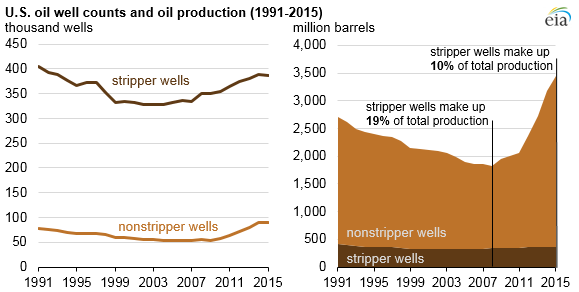Stripper wells outnumber nonstripper wells by more than 4-to-1
Stripper wells, or those that produced no more than 15 BOEPD over a 12-month period, continue to make up a significant portion of total U.S. production despite their small individual contributions.
The EIA estimates that there were about 380,000 stripper oil wells in the U.S. operating at the end of 2015 compared to about 90,000 nonstripper oil wells, meaning the stripper wells outnumber their larger counterparts by a factor of more than 4-to-1.
Wells become stripper wells through the normal decline of producing wells, some of which may have at one time been very prolific. These wells usually have low ongoing maintenance costs and relatively low transportation costs to move their products to distribution systems. As long as these wells are economically feasible, they are kept active and may continue to produce for many years.
Despite each stripper well’s small individual production, their large number ensures a significant contribution to total oil production. The production share of oil stripper wells has fallen from a high of 19% in 2008 to an estimated 10% in 2015.
This decrease in share reflects the large increase of production volume from very prolific wells drilled in shale and tight oil formations with enhanced completion techniques. These wells, as well as non-shale onshore and offshore wells in Alaska, the Gulf of Mexico, and other areas, produce at a much higher rate than stripper wells, and thus account for a much larger percentage of total U.S. oil production.


